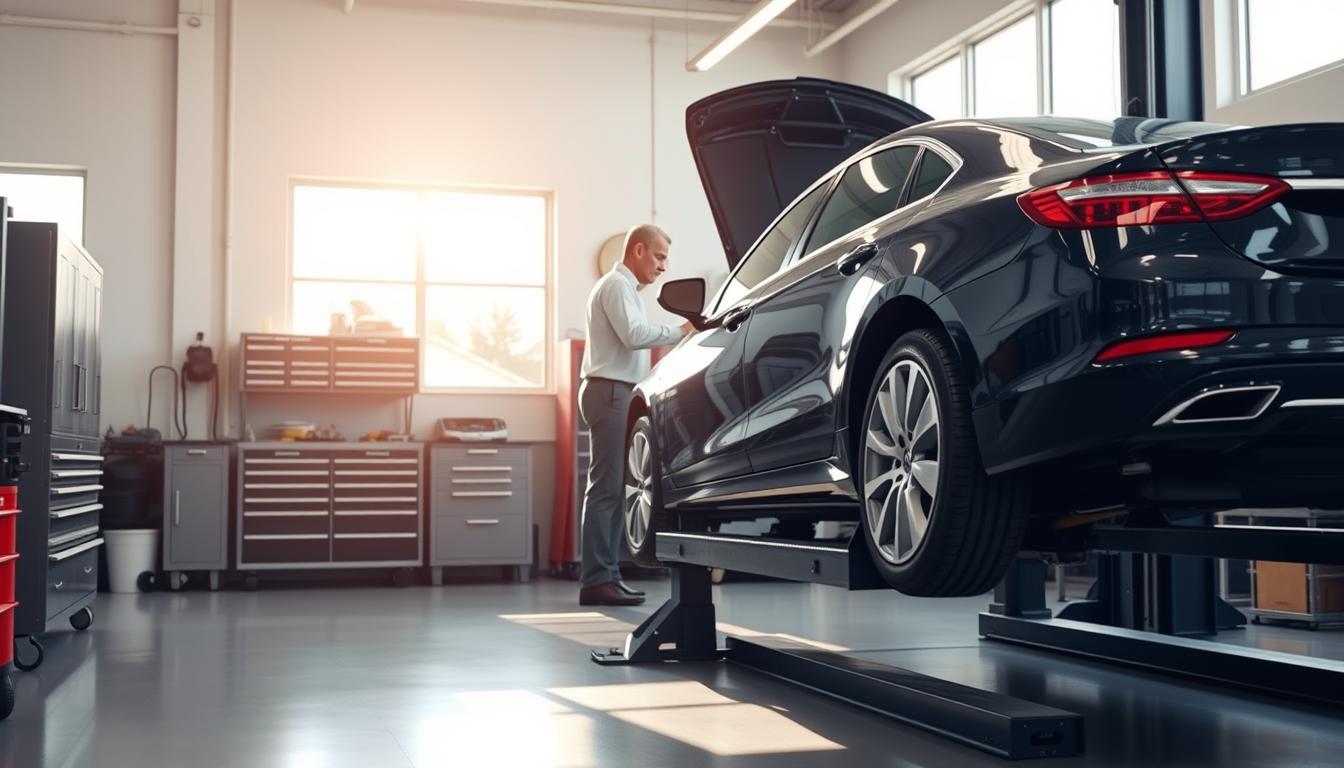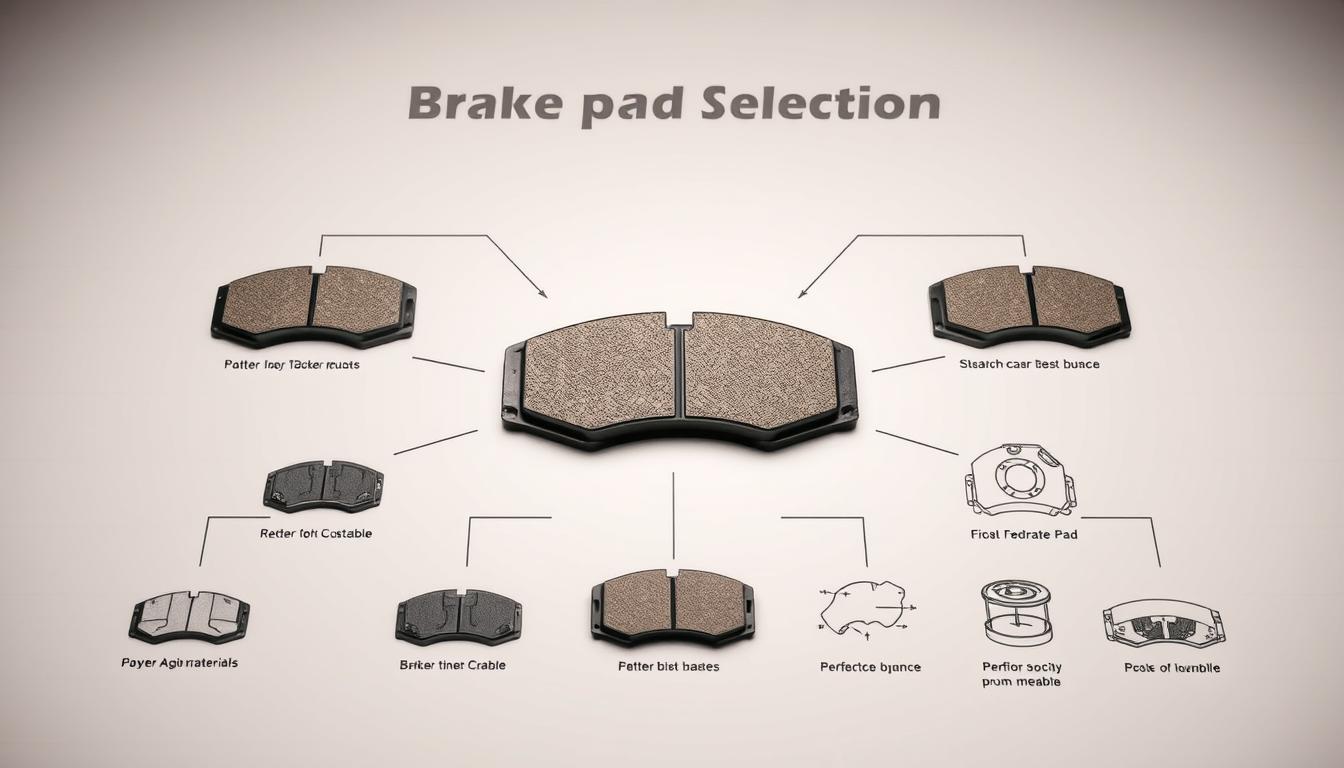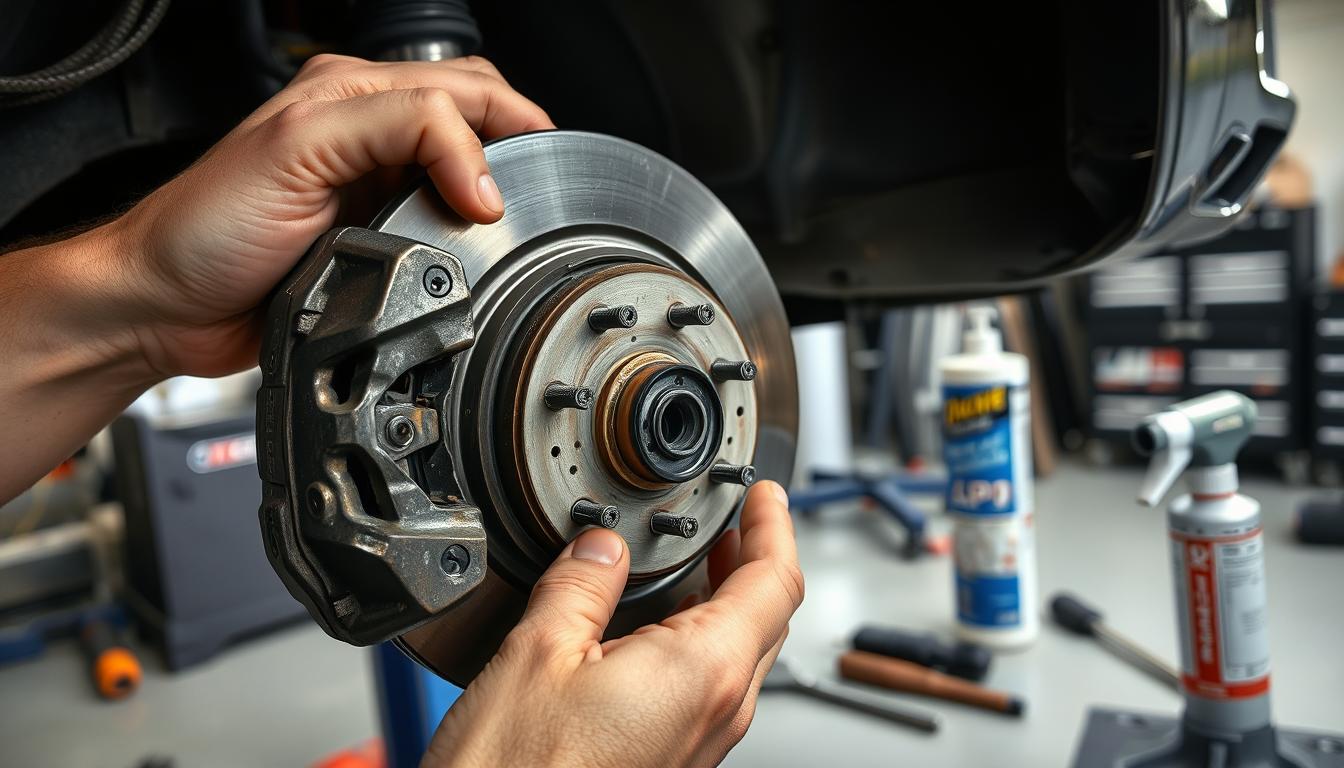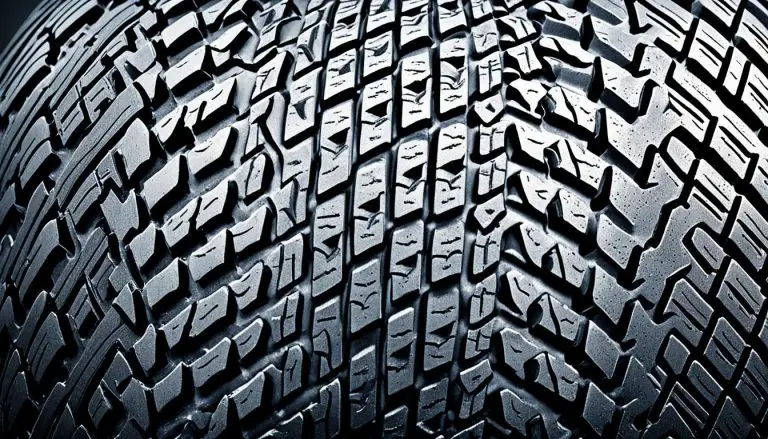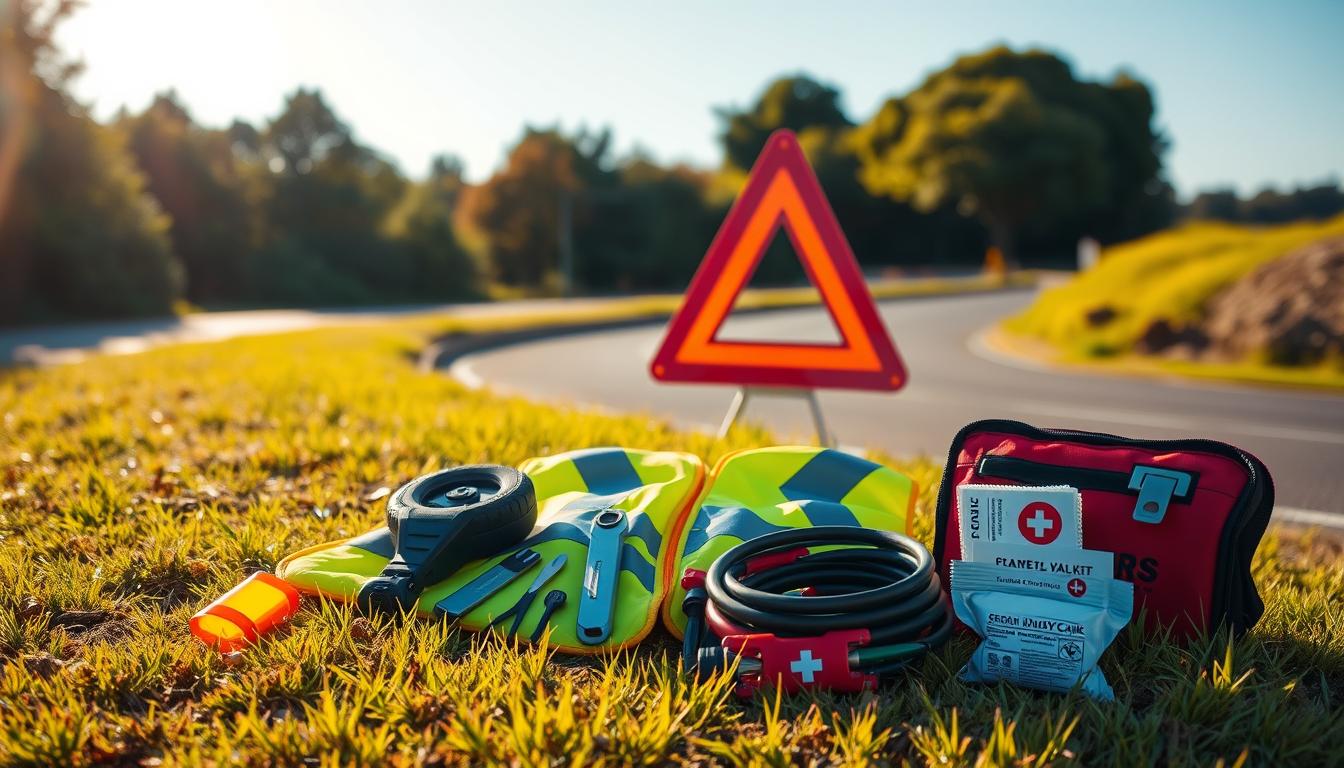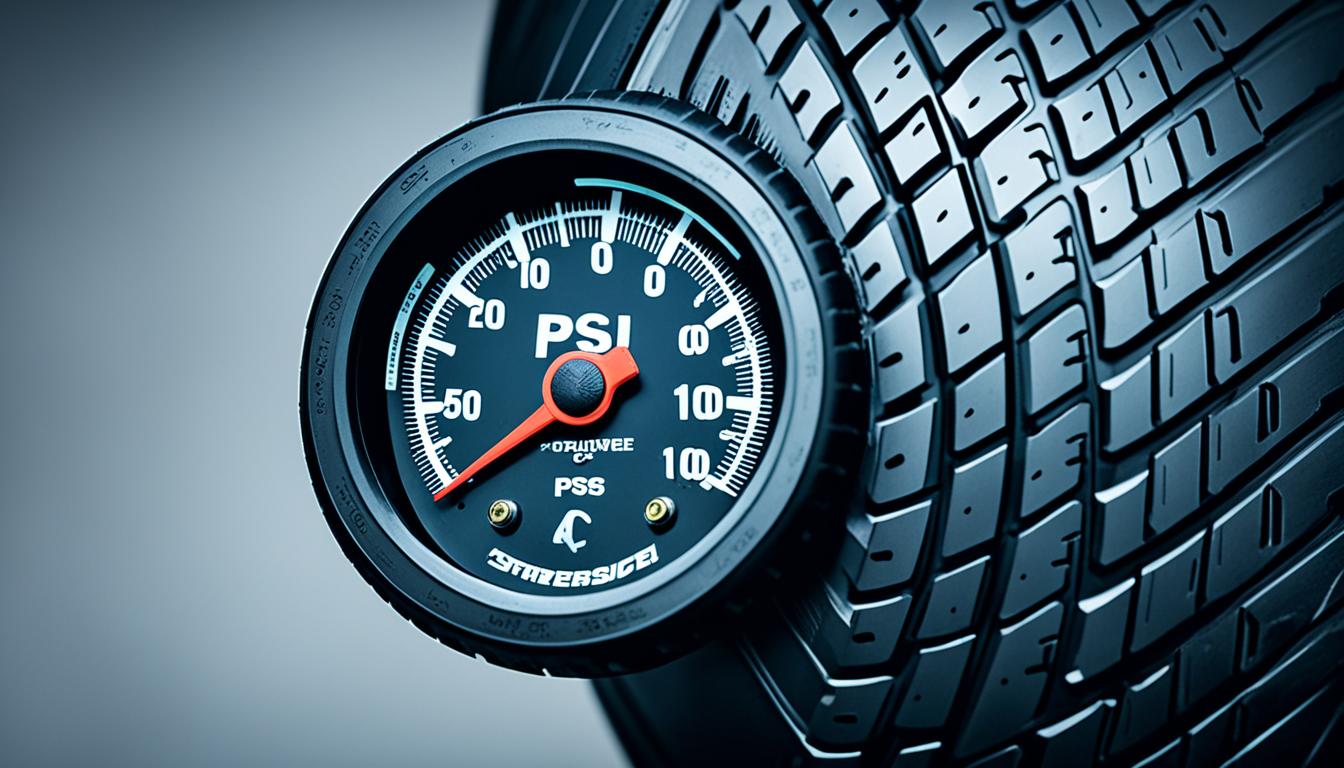
Here’s a surprising fact: just a 2 PSI drop in tire pressure can cut down your vehicle’s fuel efficiency by 1%. Getting your tire pressure right is crucial for top-notch performance and safety. It even helps your tires last longer. This in-depth tire inflation guide is your key to keeping your wheels on the right track.
No matter if you drive a sedan, SUV, or even ride a bike, knowing the correct tire pressure is vital. It can save you money on gas, keep you safer, and ensure your tires last longer. This guide has all the tips and advice you need to make sure your tires are perfectly inflated at all times.
Importance of Proper Tire Pressure
Keeping your vehicle’s tires at the right pressure is key for their best performance and long life. The benefits are several, including better gas mileage, safer driving, and tires that last longer than they should.
Improved Fuel Efficiency
Proper tire inflation lowers the effort your car puts in to move, saving gas. It’s been found out that driving on underinflated tires uses more fuel, lowering your gas mileage by at least 1%. Yet, too much air in the tires can also use up more fuel and wear them out faster, affecting their life significantly.
Enhanced Safety
The right tire pressure ensures your car steers, grips, and stops as it should. Low-pressure tires make steering slow, and your car may not go straight. This can cause sudden tire blowouts and accidents. But, tires filled correctly help your car stay on track, particularly when the road is hard to drive on.
Longer Tire Life
Following the car maker’s tire pressure recommendation makes your tires last longer. If tires are too soft or too full, they wear out irregularly and quickly. The right pressure means even wear, and your tires will live their full life. That saves you from buying new tires ahead of time.
| Tire Pressure Condition | Impact on Fuel Economy | Impact on Tire Life |
|---|---|---|
| Underinflated | Decreased by at least 1% | Reduced by 30% |
| Overinflated | Decreased by 7-15% | Reduced by 7-15% |
By ensuring your tires are at the right pressure set by the manufacturer, you get better gas mileage, drive safer, and keep your tires longer. This way, your driving stays smooth and efficient, saving you trouble and money.
Understanding Tire Pressure Recommendations
Maintaining the correct tire pressure is vital for your vehicle’s tires to perform well and last longer. You should know the recommended tire pressure from your car’s maker and the markings on the tire sidewall. This helps to keep your tires in good condition.
Vehicle Owner’s Manual Guidelines
To find out the right tire pressure for your vehicle, check your owner’s manual first. Each car model has specific tire pressure recommendations. Look for this information on a placard inside the driver’s side door jamb or in the glove compartment. It’s usually set between 28 to 36 PSI for most cars.
Tire Sidewall Markings
The tire itself shows its maximum pressure on the sidewall. This maximum is not the same as the recommended pressure. The recommended pressure is always lower, about 5-10 PSI under the maximum.
| Tire Pressure Statistics | Values |
|---|---|
| Recommended Tire Pressure for Most Passenger Cars | 30 to 32 PSI |
| Increase in Tire Pressure per 10°F Temperature Rise | 1 PSI |
| Recommended Tire Pressure Range | 28 to 36 PSI |
| Legally Mandated Tire Pressure Warning Threshold | 25% Below Recommended Pressure |
Understanding the car manufacturer’s recommended tire pressure and the tire sidewall markings is key. It ensures your tires are well-inflated. This helps with better fuel efficiency, safety, and tire longevity.
Checking Tire Pressure
It’s vital to regularly check your tire pressure for the safest and best vehicle performance. Make sure to do this when the tires are “cold,” meaning the car hasn’t been driven for at least three hours or has only moved a very short distance at a moderate pace.
When to Check Tire Pressure
Experts advise checking your tire pressure monthly to keep it at the recommended levels. This routine is crucial because weather changes can alter your tire pressure.
The general estimate is that for every 10-degree temperature drop, tire pressure falls by 1 pound per square inch (psi).
Using a Quality Tire Gauge
Get yourself a dependable tire pressure gauge for accurate readings. You can find digital and analog gauges in most auto shops. It’s a bad idea to use gas station pumps for checking pressure. They’re often not well-maintained and could be off.
Remember, front and rear tires might need different pressure. You can know the correct levels from a label on the driver’s side door jamb or your car manual.
Having the ideal tire pressure has many advantages. It leads to longer-lasting tires, prompt steering, improved gas mileage, and a comfortable drive. Using a trusted gauge for frequent checks keeps your tires in top shape.
tire inflation guide
Maintaining proper tire inflation is key for your vehicle’s performance and safety. This guide covers the need, suggestions, and methods for ideal tire pressure. Keeping your tires at the right pressur helps your drives to be smooth and safe.
Understanding Tire Pressure Recommendations
You can find the recommended tire pressure on a sticker in the driver’s side door jamb. It shows the ideal pressure for both the front and rear tires. Some vehicles might require different pressures for their front and rear wheels.
If you can’t locate the sticker or missing your owner’s manual, sidewall checking of tires works too. This displays the maximum inflation pressure they can take. Remember, this is the maximum, not the recommended pressure.
Checking Tire Pressure Properly
- Use a high-quality tire gauge to measure the pressure in each tire, including the spare, when cold.
- Check the pressure once a month and before long trips to keep them properly inflated.
- Know that tire pressure may change by about 1 PSI for every 10-degree change in outside temperature.
Adjusting Tire Pressure for Optimal Performance
After selecting the right tire pressure for your car, adjust it as needed. Too low pressure can cause stress and damage to the tires. Too high pressure poses a risk of bursting or handling issues. Always aim for the proper balance.
| Condition | Recommended Tire Pressure |
|---|---|
| Normal Driving | Manufacturer’s Recommended Pressure |
| Heavy Loads | Increased Pressure (Up to Maximum Sidewall Rating) |
| Off-Road Driving | Decreased Pressure (For Improved Traction) |
Following this detailed tire inflation guide ensures your tires are at optimal pressure. This enhances performance, safety, and fuel use. For more info, visit tire pressure and tire inflation.
Adjusting Tire Pressure for Different Conditions
Maintaining correct tire pressure is vital for top vehicle performance and safety. Weather changes affect tire pressure. It is crucial to adjust inflation for smooth rides in various climates.
Hot Weather Considerations
Hot summer days cause the air in tires to expand. This raises the tire pressure, possibly overinflating them. Experts advise checking your tires more often in heat. Always adjust them to meet the recommended PSI levels.
Cold Weather Considerations
Cold weather has the opposite effect, decreasing tire pressure. As a general rule, tire pressure falls by about 1 psi for each 10ºF drop. To keep your tires at their best in the cold, check and adjust them frequently.
- Adjust your tire pressure to the recommended levels for colder temperatures, typically around -20ºF, to account for the expected drop in pressure.
- Keep a close eye on tire pressure and tweak it as the temperature changes through the day.
- Do not overinflate tires in very cold weather. It can slow the warming process and decrease grip.
Vigilance in keeping your tires properly inflated ensures your vehicle remains safe and effective in all weather. Remember, the right inflation supports not just performance, but responsible car care too.
Road Bike Tire Pressure
When it comes to road bikes, a recommended tire pressure range is usually found between 85-110 PSI for tube-type clincher tires. For tubular tires, this range is wider, from 150 to 200 PSI. Your choice of tire pressure greatly affects your ride’s feel and how well your bike performs.
Smooth Pavement Recommendations
On smooth pavement surfaces, higher tire pressures, nearer to the top end of the range, are typically favored. This choice enhances roll efficiency and speed by reducing the resistance. For cyclists familiar with the road, aiming for 100-110 PSI on well-maintained roads is common practice.
Wet Conditions Recommendations
Yet, in wet conditions, opting for slightly lower pressures, closer to the lower limit, is advised for improved traction and to avoid hydroplaning. Lowering the pressure by about 5-10 PSI can vastly increase the tire’s gripping surface on wet roads. This lets the tire better conform to and maintain contact with the slick surface.
| Tire Condition | Recommended Tire Pressure (PSI) |
|---|---|
| Smooth Pavement | 100-110 PSI |
| Wet Conditions | 90-100 PSI |
Keep in mind, the perfect tire pressure is also influenced by your weight, the tire’s width, and what you personally prefer. Experimenting with various pressure levels and closely observing how it impacts your ride can guide you to an ideal setting for your road bike.
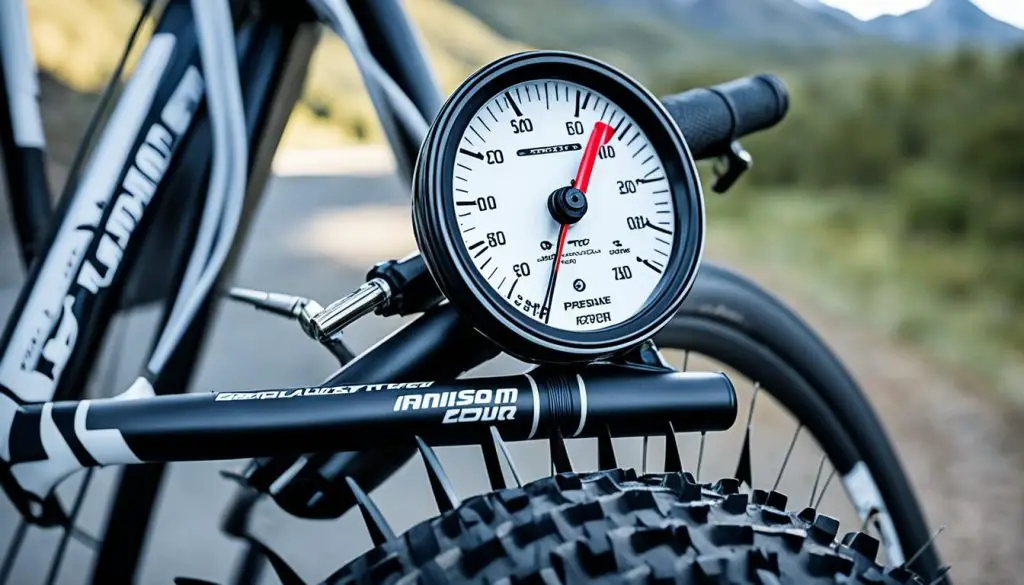
Mountain Bike Tire Pressure
Mountain biking’s impact is significantly influenced by the right tire pressure. Proper inflation enhances traction and cushioning, improving your overall performance. This prepares you for various terrains, solidifying your stance with each ride.
Trail Riding Recommendations
On smoother, well-maintained trails, your mountain bike operates optimally at higher tire pressures, typically 35 to 65 PSI. This boosts your bike’s rolling efficiency, keeping you moving swiftly with less exertion.
Technical Terrain Recommendations
For technical trails with obstacles like rocks and roots, opt for lower pressures, around 35 to 45 PSI. This approach aids your tires in conforming to the rugged terrain, boosting grip and comfort. It’s especially useful for tricky maneuvers like steep descents and sharp turns.
Finding the ideal tire pressure hinges on balancing efficiency and grip. To pinpoint the best pressure, check out guidance from Singletracks, Enduro-MTB, and Norty Youth Cycling. They offer tools to tailor your tire inflation to your bike, the terrain, and your own riding style.
Choosing the right tire pressure transforms your mountain biking adventure. By adapting your tire pressure to the terrain and your style, you improve traction, comfort, and biking experience. This ensures you are ready for any trail ahead with increased confidence.
Hybrid Bike Tire Pressure
Recommended tire pressure for hybrid bikes falls between 60 and 85 PSI. This span ensures a mix of speed on pavements and comfort on tough ground. By adjusting pressures, you tailor your bike for different terrains and personal comfort levels.
For rough tracks or varying surfaces, opt for the lower end (around 60 PSI). This choice adds cushion and grip, helping you handle uneven paths. Around 85 PSI, at the upper range, fits rides on roads, making your bike roll faster and smoother.
Keep a close eye on and fine-tune your hybrid bike’s tire pressure often. This step maintains top-notch performance and keeps you safe. Tires with low air are prone to damage and are less efficient. On the other side, too much air means a bumpy ride and a higher chance of tire issues.
By sticking to the recommended pressure range, your hybrid bike will be ready for any ride. You’ll enjoy comfortable, efficient, and safe cycling over all types of terrain.
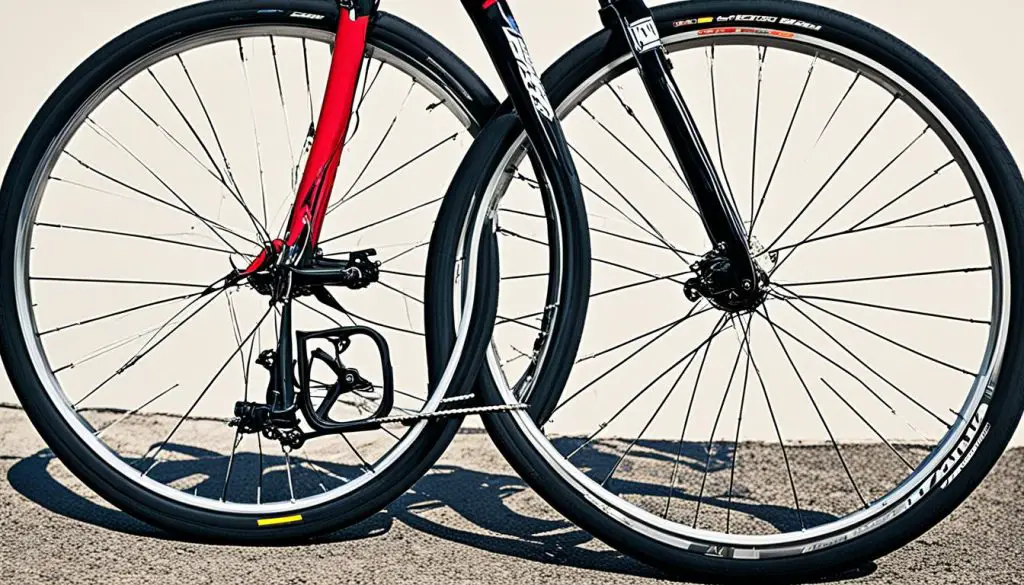
Fat Bike Tire Pressure
Choosing the right tire pressure for fat bikes is crucial. It changes a lot based on where you’re riding. For soft terrains like sand or fresh snow, low pressures between 5-10 PSI are best. These help the tires grip well and ‘float’ on top. This keeps you moving with better control over the loose ground.
Soft Terrain Recommendations
On soft ground like sandy beaches or powdery snow, go for 4-6 PSI. Lower pressures make the tires spread out more. This gives you superior grip and keeps you on top. In wet sand close to the water, try a bit more air, about 6-8 PSI, for better performance.
Hard Surface Recommendations
On tougher surfaces such as packed trails or roads, raise your tire pressure to 20-30 PSI. Higher pressure helps your bike’s efficiency. It lowers resistance and makes it easier to go fast. Remember, the maximum pressure for most fat bike tires is about 20 PSI. Staying within this range is key for the best ride and safety.
FAQ
Q: What are the benefits of maintaining proper tire pressure?
A: Keeping an eye on your tire pressure comes with key perks. For starters, it boosts how far you can go on a tank, making your car more efficient. Plus, there’s a big safety bonus, as tires at the right pressure level grip the road better. Lastly, your tires will last longer.
Q: Where can I find the recommended tire pressure for my vehicle?
A: Check your owner’s manual or take a peek at the tire’s sidewall. Both places will tell you the recommended tire pressure.
Q: When is the best time to check my tire pressure?
A: Aim to check tire pressure when your wheels are cold. This means after your vehicle has been sitting without running for three hours or more, or after driving less than a mile.
Q: How does weather affect tire pressure?
A: Think of tire pressure like Goldilocks’ porridge—it changes with the weather. Hot days can inflate tires as air inside them expands. Yet, colder spells do the opposite, causing tires to lose pressure.
Q: What is the recommended tire pressure range for road bikes?
A: Road bike tires should be kept between 85 and 110 PSI —that’s for the tube-type clincher kind. Those fancy tubular tires need a bit more, sitting happy between 150 and 200 PSI.
Q: What is the recommended tire pressure range for mountain bikes?
A: For the off-road adventurers, mountain bike tires should hover around 35 to 65 PSI. Lower air pressure means more rubber on the dirt, giving you traction and a softer ride, especially on tricky ground.
Q: What is the recommended tire pressure range for hybrid bikes?
A: Hybrids roll best with tire pressures ranging from 60 to 85 PSI. It’s a sweet spot, balancing speed on asphalt with a bit of give for bumpier routes.
Q: What is the recommended tire pressure range for fat bikes?
A: Those chunky fat bike tires? They peak at about 30 PSI in terms of pure pressure but the range is wide. Find folks riding with as little as 5 to 10 PSI in soft sand or snow, yet up to 20 to 30 PSI on firmer trails.
